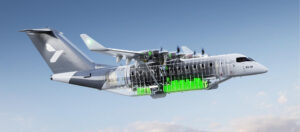Heart Aerospace, a Swedish startup, has teamed with BAE Systems, a veteran British aerospace supplier, to help with powering its 30-seat, battery-powered airliner. The four-motor craft will include a very large battery pack under the passenger compartment. The need for safety should be obvious.
Adding eleven seats to its original 19-seat platform, Heart also brings a turbo generator on board, enabling flights up to 400 kilometers (250 miles) with 30 passengers, or even 800 kilometers (500 miles) with 25. These figures include normal airline range reserves.
Partners include BAE Systems, Swedish aerospace group Saab, avionics supplier Garmin, and Aernnova, a Spanish airframe specialist.
BAE’s UK-based group’s Controls and Avionics Solutions operation in upstate New York will oversee the batteries and their control and monitoring. This fits BAE’s expertise, with more than 25 years of experience electrifying large, heavy-duty industrial vehicles with over 15,000 power and propulsion systems in service worldwide. This will be critical considering the placement of the batteries.
Reducing and Even Eliminating the Risk
Heart’s chief operating officer, Sofia Graflund, has confidence in BAE’s ability to deliver a safe power system. Reflecting on BAE’s experience with “critical safety systems for aerospace,” she adds, “We look forward to decarbonizing air travel together.”
As you can guess, a lithium battery fire would be fairly disastrous for passengers, so preventive measures are absolutely necessary. Designers buffer the Li cells with iron phosphates, for instance. BAE is experienced in creating battery management systems (BMS) to counter thermal runaway in individual cells and keep such negative events from spreading.

Location of very large battery pack necessitates absolute suppression of hazards
A Tesla has over 7,000 individual battery cells in the pack under the floor. Somehow, that firm prevents dramatic events far better than we seem able to stop gas-powered car fires (174,000 per year in America).
Note that car fires started going down after manufacturers started using fuel injection instead of carburetors. Still, we have 477 petrol car fires a day.

Note the decline in car fires after makers started installing fuel injection to replace carburetors
A comparison between fossil fuel powered vehicles and battery powered ones elicits an interesting anomaly. Hybrids experience more than double the number of fires of gas-powered ones, with electric vehicles being far safer.

Oddly, hybrid cars seem to have far more fires than petrol or straight battery-powered types
Aircraft, following what will be fairly strict standards, will have UL or other certifying agencies’ stamps of approval, and use far better tested cells than those used in budgets e-bikes or hoverboards. They will also be encased in stringently designed and constructed packs with high standards of control. BAE is well experienced in such things.
A Strong Opening Market
Money talks, and the large number of airlines investing theirs, or expressing an interest in the new airplane is growing. A new ES-30 industry advisory board “includes representatives from 21 airlines, including Air Canada, Air New Zealand, Cebu Pacific, Icelandair, and United Airlines among others. United Airlines also committed to a future purchase agreement for up to 100 electric aircraft from Heart Aerospace. The startup has also received letters of intent from SAS, Wideroe, Air Greenland, and Finnair, among others.” Air Canada has signed a purchase order for 30 ES-30s, and United Airlines has signed on for another 100.
Whatever qualms one may have about the placement of batteries in the airplane, there seems to be a growing number of airlines willing to place their trust in this new craft. It will certainly introduce a new level of service to the regional market.

